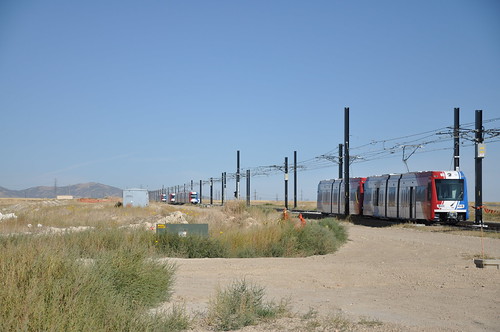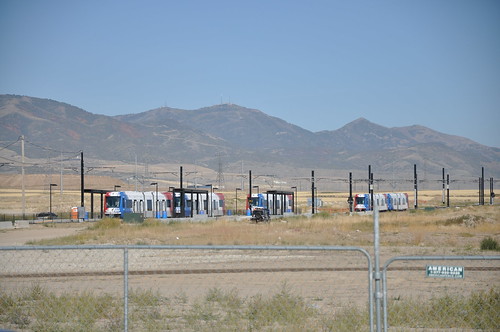When I lived in Austin I ate dinner and lunch every day at a place called the University Towers. Rather than paying $10 a meal at the athletes dining hall my teammates and I could get a meal plan at the private dorms for about $4.50 a meal. For athletes that ate a lot this was an amazing deal and also good time for teammate bonding. It was such a great deal that I ate there with my old teammates all the way through grad school. I had the choice so why not take it?
To get there I had to walk through West Campus every day. I often thought that it was underdeveloped and a bit ragged and would dream about how things could change with a little development on my ride home either on the #1 or the #5. That dream seems to have come true, perhaps a bit more than even I thought possible.

In Austin if you heard West Campus in the first half of the 2000s, you might automatically think of the dense neighborhood West of the University full of frats, sororities, and kids with extra money to spend in order to live closer. If you had less cash, you lived North, South, or on Riverside. By the time I left, the city had finally upzoned the neighborhood, much to the chagrin of some neighbors that lived in the area, to allow redevelopment of properties that had fairly poor upkeep due to the captive audience of students and the very limiting height restrictions against heavy demand. I found that a post by the
Old Urbanist was very informative on this point and I didn't realize it matched that until today.
Basically, the rent was high but much of the quality was horribly low. When looking for an apartment one time I remember this one place called the
Sandpiper. It was one of those old motel looking complexes. For $850 a month you could get the worst two bed room in West Campus. And that was back in 2002.
As Chris Bradford at the Austin Contrarian
shows, there was a lot of development that took place and the census shows that the area had really high growth rates. So high in fact that recently there have been rumblings as to whether the infrastructure
could handle all the development. Well after the rezoning it seemed like there was a new crane in the sky each month. This led to around 3,700 new residents according to Chris' calculations.
At that same time, Riverside which was a popular area for students when I was in school seemed to be declining in population as a whole losing
over 2,000 residents. Additionally, ridership on the West Campus bus has gone up while overall Riverside ridership has dropped.

According to numbers provided by Capital Metro, (thanks to JMVC) ridership in the fall, which has greater ridership than spring, has increased for the West Campus bus by ~1,200 students a day between 2006 and 2010 while the Riverside buses have lost about ~880. Obviously correlation is not causation but you can make a pretty good bet that there was some sort of shift happening. And it wasn't just coming from Riverside, but probably all areas of the city where students were living. Given the rise of 3,700 residents in West Campus, you would think there would be an even greater ridership bump on the West Campus Bus. But a lot of the new folks probably now just walk or bike.
But what else does the shift mean? Well for one thing I think that West Campus gives us a perfect example of how zoning close to Downtowns in major cities can stifle what the market actually wants to provide. Given the choice, I don't know of any college students that wouldn't love rolling out of bed five minutes before class (8am or otherwise) with the ability to get to class on time because they just had to walk or bike quickly. Additionally, there are a lot of people that want to live in proximity to great neighborhoods just outside of downtown in most cities.
But that's also another piece of the regional and national puzzle, if there was a shift from Riverside to West Campus of 800 former Riverside riders or so, that is likely a huge reduction in VMT. Mostly because if you live on Riverside, you own a car and have to drive everywhere. Though the grocery store is close to many of the apartments aimed at students, you couldn't just walk to the library on campus to study or go to parties in West Campus Friday nights. Driving was the only option. Not to mention that the bus passenger miles were much higher going to school.

Checking the Walkscore for Riverside and West Campus, you get an idea of what happens. As you can see below, the Walkscore for Riverside is 56 with the neighborhood the 40th best in Austin. That means lots of driving. Over in West Campus, the Walkscore is 86, second highest in the region. Imagine the VMT difference of those 3,700 new residents now living in West Campus who probably walk to Double Dave's for some pizza rolls rather than driving there.


And I didn't have a lot of time to look at it, but if those 3,700 residents moved out of housing in Riverside and other student areas, and the demographics of those areas changed. Does that mean that these areas became more affordable? Did the rents change? That would be interesting to look at as well.
Ultimately I think this is a lesson for other cities as well. Folks like
Lydia DePillis in DC arguing against the height limit should not look to Austin's future plans, which looks like more skyscrapers on the way, but rather to what they've already done with changes in zoning that freed up the market in West Campus. Additionally, the
Georgetown folks could learn from this as well.
Austin can learn from itself too, as Chris discussed in his post about the
Suicide Pact. Not only is it about schools and kids, but its about quality of life for the region as a whole. Reductions in VMT will come when people are able to live where they want. There's a high demand for walkability and proximity to work and less time spent in cars. In that sense, people already want to do the right thing, we're just not letting them.
Capital Metro UT Shuttle Data Extra...



























